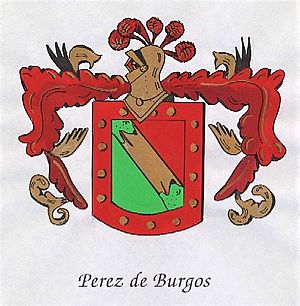Francisco Pérez de Burgos facts for kids
Quick facts for kids
Don Francisco Pérez de Burgos
|
|
|---|---|

Coat of Arms of Pérez de Burgos
|
|
| Escribano Mayor de Gobierno of the Río de la Plata | |
| In office 1589–1607 |
|
| Monarch | Philip III of Spain |
| Preceded by | Antón García Caro |
| Succeeded by | Manuel Martin |
| Alcalde of Buenos Aires | |
| In office 1593–1594 |
|
| Monarch | Philip II of Spain |
| Preceded by | ? |
| Succeeded by | ? |
| Personal details | |
| Born |
Francisco Pérez de Burgos y Martínez
1558 Cádiz, Andalusia, Spain |
| Died | 1617 Buenos Aires, Argentina |
| Spouse | Juana de Aguilar y Salvatierra |
| Occupation | notary government army farmer |
| Profession | jurist |
| Signature |  |
| Military service | |
| Allegiance | |
| Branch/service | Spanish Army |
| Years of service | 1581-1610 |
| Rank | Captain |
| Unit | Fuerte de Buenos Aires |
Francisco Pérez de Burgos (1558-1617) was an important Spanish official. He was a jurist (someone who studies law), a soldier, a merchant, and a politician. He played a big role in the early history of Argentina, especially in the city of Buenos Aires.
He worked as a public and government notary, which meant he officially recorded important documents. The King of Spain, Felipe II, even appointed him as a Royal Notary. He also held many other important jobs in the Viceroyalty of Peru, including Mayor of Buenos Aires and Corrientes. He was also a Regidor (a council member) of the Cabildo of Buenos Aires, which was like the city council.
Contents
Francisco Pérez de Burgos: His Life and Work
Early Life and Move to the Americas
Francisco Pérez de Burgos was born in 1558 in Jerez de la Frontera, a city in Cádiz, Spain. His parents were Diego Pérez de Burgos and Beatriz Martínez de Tremal. His family was well-known in the region of Andalusia.
He likely studied in Seville. In 1581, he traveled from Cádiz to the Río de La Plata region in South America. He first lived in Asunción before settling in Buenos Aires in 1583. There, he married Juana de Aguilar y Salvatierra.
Important Roles in Buenos Aires
Pérez de Burgos took over the job of notary in Buenos Aires from Antón García Caro. He worked as a public notary and for the city council until 1606. His job was to officially record important documents and decisions. In 1606, he showed the City Council his official title as Royal Notary of the Spanish Indies. King Philip II of Spain himself had signed this title on February 11, 1581.
He was very active as a government notary in the Río de la Plata area. For example, in 1584, he recorded the official questioning of three English pirates. These pirates had been chased by the Charruas Indigenous people in the Santa Fe Province. One of these pirates was John Drake, who was the nephew of the famous English explorer Francis Drake.
Other Positions and Contributions
Francisco Pérez de Burgos was part of the second group of settlers who established the city of Buenos Aires. He also lived in other areas like San Miguel de Tucumán, Santa Fe, and Corrientes. In 1596, he was appointed by Juan Ramírez de Velasco to be the Mayor and Chief Justice of Corrientes.
He also served as Mayor of Buenos Aires and was a Captain in the Fuerte de Buenos Aires, which was the fort protecting the city. In 1614, he was chosen as a regidor (council member) again. He was also appointed as fiel ejecutor of Buenos Aires, a role that involved ensuring fair prices and measures in the market. He continued to serve on the City Council of Buenos Aires until 1616.
Pérez de Burgos also worked as a farmer. He was involved in hunting wild cattle in the Province of Buenos Aires. In 1604, he received land grants near the Paraná River from Hernando Arias de Saavedra, who was the governor of Buenos Aires. He owned a farm located near the Riachuelo, south of the city.
The "passage of Burgos" (pasaje de Burgos), which is now called Puente Alsina, was named after Francisco Pérez de Burgos. During the British invasions of the Río de la Plata, British troops used this passage to enter the city of Buenos Aires.
Francisco Pérez de Burgos passed away in Buenos Aires on July 21, 1617.
Family and Legacy
Francisco Pérez de Burgos and his wife, Juana de Aguilar y Salvatierra, had many children. One of their daughters was Leonor de Aguilar Pérez de Burgos. She married Francisco de Manzanares y Dardos, a Spanish official from Toledo. Another daughter, Catalina Burgos de Aguilar y Salvatierra, married Juan Rodriguez de Estela. Their descendants include important figures like Feliciano Pueyrredón and Juan Martín de Pueyrredón.
The Pérez de Burgos family line may have come from Garci Perez de Burgos or Ferrán Pérez de Burgos. These were Spanish noblemen from Burgos who helped in the conquest of Jerez de la Frontera. They served the Kings of Castile.
See also
 In Spanish: Francisco Pérez de Burgos para niños
In Spanish: Francisco Pérez de Burgos para niños

